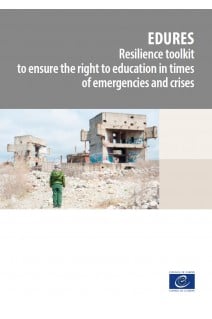Access to quality education is vital in times of emergency. It helps learners make sense of the crises they are experiencing, mitigates trauma and alienation and contributes to longterm recovery and peacebuilding.
Developed under the Council of Europe Education Strategy 2030 “Learners First”, the toolkit provides practical guidance to help education systems prepare for, respond to and recover from emergencies such as conflicts, natural disasters and pandemics. It aims to ensure that the right to quality, inclusive education is upheld for all learners, everywhere and at all times.
The EDURES toolkit builds on the six Principles of Resilience for Education, adopted by European education ministers in 2023, and offers a comprehensive framework combining theory, practical tools and self-assessment instruments. It supports policy makers, education authorities and school leaders in designing and implementing resilience-based strategies through participatory and evidence-informed approaches.
Already piloted in member States such as Italy and Albania, EDURES contributes to the broader international efforts to transform education in crisis contexts, in line with the United Nations’ Transforming Education Summit commitments.
By investing in education resilience, the Council of Europe and its partners reinforce democratic stability, social cohesion and learners’ well-being — even in the most challenging circumstances.
FOREWORDCHAPTER 1 – INTRODUCTION
1.1. Education and resilience: the work of the Council of Europe
1.2. The six principles of resilience for education
1.3. EDURES toolkit
CHAPTER 2 – CONCEPTUAL FRAMEWORK FOR EDUCATIONAL STRATEGIC PLANNING
2.1. Rationale 11
2.2. From strategic planning to operationalisation: EDUSTRAT
2.3. EDUSTRAT – Definitions
2.4. Learning environments
2.5. Resilient learning environments
CHAPTER 3 – EDURES MANUAL
3.1. Contextualising resilience for education
3.2. The EDURES road map
CHAPTER 4 – EDURES PILOTING ACTIONS – FIRST YEAR OF IMPLEMENTATION
4.1. Friuli Venezia Giulia region
4.2. Albania
4.3. Preliminary results of the pilot project activities
Conclusions
BIBLIOGRAPHY APPENDIX 1 – EDURES BENCHMARK
The benchmark indicators
Benchmark – The targets
APPENDIX 2 – EDURES E-TOOL: PRACTICAL HANDBOOK
Introduction
Objectives
Implementation road map
Phase 1 – Setting up an ERT
Phase 2 – Assessing resilience of educational ecosystems
Phase 3 – Setting objectives for resilient educational ecosystems
Phase 4 – Action planning for resilience
In short
E-TOOL: USER MANUAL
Structure of the e-tool
Evaluation in dimensions
Results analysis and strategic planning
Practical example




